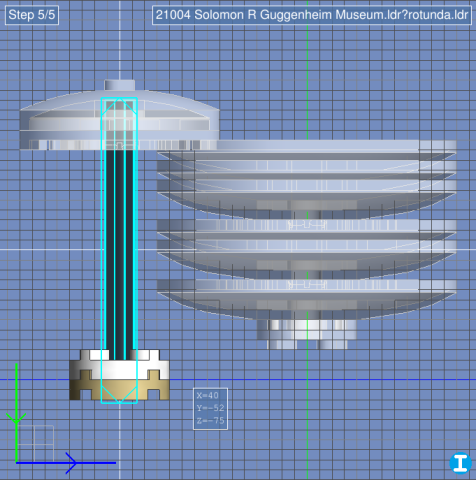I found a measurement discrepancy in set 21004 between the LDraw version and the real thing. I know that sometimes things don't work out precisely between the two, but in this case there's a mismatch of exactly 4 LDU, and I'm trying to pinpoint why.
This involves the rotunda section with its stacked 6x6 dishes and 4x4 round plates, and the 6L axle that supports it. Here are the precepts:

As you can see, the 4x4 dish and plate at the top are 4 LDU too high, because the rest of the assembly is only 104 LDU high rather than the necessary 108. Where is that extra 4 LDU coming from?
I thought perhaps the axle hole in the 4x4 dish should be 16 deep instead of 12, but a rough measurement of the real part suggests that 12 is correct. All of the dishes seem to be modeled at their correct height, too, so the only thing I can think of is the axle. Indeed, measuring the real axle shows that it's just a bit over 47mm long, not 48. It may even be 47.2mm, leaving it 2 LDU short of its theoretical length, but that still leaves another 2 LDU to account for. Could the height of the embossed stud logo account for that (see the 2x2 round plates at the bottom), or just the natural physical play between parts?
This involves the rotunda section with its stacked 6x6 dishes and 4x4 round plates, and the 6L axle that supports it. Here are the precepts:
- The 6L axle has a length of 120 LDU, nominally equal to 48mm in real life.
- As we know, plate height is 8 LDU (12 with the studs), so two stacked plates are 16 LDU high (20 with studs).
- The center of the 6x6 dish has the ordinary plate height of 8 LDU, and the cavity adds another 8 LDU, making it equal to two stacked plates in height.
- As a result, the 4x4 round plate sits entirely flush within the 6x6 dish.
- Per the instructions, and confirmed in the physical set that I own, the 4x4 round plate at the top of the assembly sits fully within the uppermost 6x6 dish, and the bottoms of both that dish and the 4x4 dish should be at equal height.
- The axle hole in the 4x4 dish is 12 LDU deep.
As you can see, the 4x4 dish and plate at the top are 4 LDU too high, because the rest of the assembly is only 104 LDU high rather than the necessary 108. Where is that extra 4 LDU coming from?
I thought perhaps the axle hole in the 4x4 dish should be 16 deep instead of 12, but a rough measurement of the real part suggests that 12 is correct. All of the dishes seem to be modeled at their correct height, too, so the only thing I can think of is the axle. Indeed, measuring the real axle shows that it's just a bit over 47mm long, not 48. It may even be 47.2mm, leaving it 2 LDU short of its theoretical length, but that still leaves another 2 LDU to account for. Could the height of the embossed stud logo account for that (see the 2x2 round plates at the bottom), or just the natural physical play between parts?












